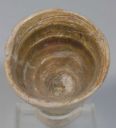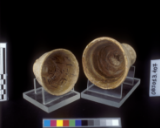King Minos and the Minoan civilization
Minos, son of the Greek god Zeus and the goddess Europa, was the mythical king of Crete. He was known for his Daedalean labyrinth, in which his monstrous stepson the Minotaur, half man and half bull, lived,. When the British archaeologist Arthur Evans excavated Knossos, Crete in 1900, he came across the foundations of an enormous labyrinthic building which reminded him of 'The Palace of Minos', after which he would name his later book about his excavations and theories on the Minoan civilization (1921) [[Cf]](https://www.worldcat.org/search?q=no%3A7693278670. Because of this resemblance between the labyrinthic structure and because Evans found frescoes with bulls – reminiscent of the legendary Minotaur – he called this Cretan civilization that he had excavated the Minoan civilization (3000-1100 BCE), a civilization that preceded the then already known Mycenaean civilization on the Greek mainland.
The term ‘palace’ that Evans gave to the labyrinthic site is a slightly misleading name for the huge buildings found at Knossos, Phaestos, Myra, Zakros and other Cretan sites. ‘Palace’ suggests a single building that serves as a monarchic center. We cannot be sure, however, whether there was such a royal center due to lack of archaeological and written evidence, but we do know that instead of a single residency, these palatial sites were complex structures of many interconnected smaller buildings that served as a center for religious, administrative and economic purposes.[Palyvou 2018, 185-187]
These palatial buildings and towns arose around 2000 BCE and flourished mainly in the ‘Golden Age’ of the Minoan civilization around 1700-1450 BCE, the period in which this civilization also became remarkable for its sophisticated art, its writing system, and its trade with the surrounding flourishing civilizations. During his excavations at Knossos, Evans found many of those remarkable artefacts, such as thousands of inscribed clay tablets, painted frescoes and a wide range of ceramics. One of his findings was this clay cup, together with a similar painted clay cup and a complete pithos in the foundations of a floor in his ‘Palace of Minos’.[Evans 1909, 29]
After this Golden Age, many palaces – except that of Knossos – were destroyed possibly by natural disasters, but probably also by external invasions and by the growing power of the Mycenaean civilization prospering on the Greek mainland. In the 13th century BCE, Knossos was also destroyed. This marked the beginning of the end of Minoan civilization.
](https://micrio.thingsthattalk.net/zLfYv/views/max/128x128.jpg)
](https://micrio.thingsthattalk.net/DHKXy/views/max/171x128.jpg)
](https://micrio.thingsthattalk.net/vIOja/views/max/189x128.jpg)
.jpg)](https://micrio.thingsthattalk.net/vnENj/views/max/128x128.jpg)
](https://micrio.thingsthattalk.net/Lgjet/views/max/209x128.jpg)

